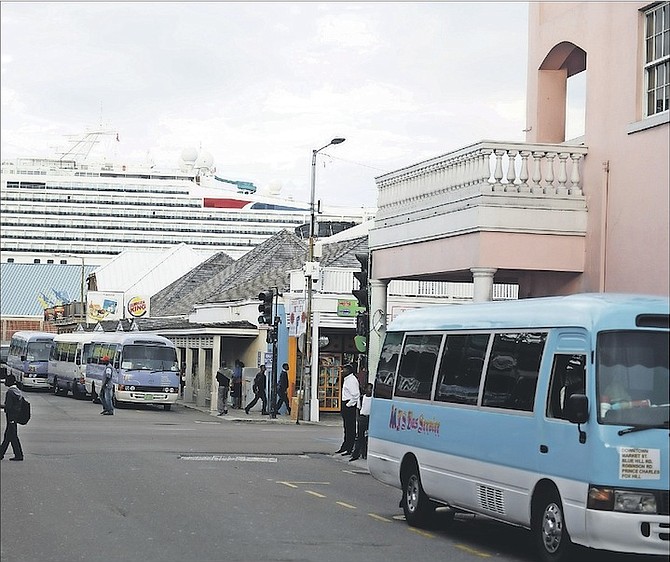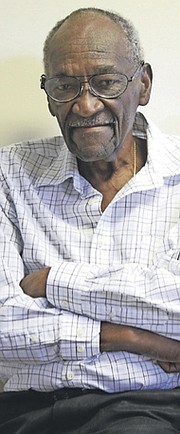Jostling jitneys in downtown Nassau reveal a lack of co-ordinated transport schedules which leads to traffic congestion. Photo: Shawn Hanna/Tribune Staff
Paul Thompson renews his call for a modernisation of the Bahamian public transport system . . .
Paul Thompson is the quintessential policeman. His career spanned the modern development of The Bahamas - from colonial times to the challenges of nationhood.
Born in a small farming village in Trinidad, he was recruited by the Royal Bahamas Police Force in 1951. He spent most of his time on the force in the Criminal Investigation Department, retiring in 1981 as an Assistant Commissioner.
He then began a second career as head of security for the Paradise Island Resort & Casino, returning to the police force as a civilian training officer in 1998, and in 2002 was appointed general manager of Wemco Security.
Five years later, he set up his own security company - Paul Thompson & Associates. Now in his 80s, he remains active in security work.
Years ago, I wrote an article for The Tribune calling for a major upgrade to our public transportation system in order to increase safety and efficiency while reducing traffic congestion.
I am not the only one to have made such calls over the past decades - and over several political administrations. But despite the fact that modernisation is so clearly in the public interest, absolutely no progress has been made.
Anyone who is uncertain about this should take a look at Bermuda’s highly efficient and safe public bus system. Buses are frequent, plentiful and service most points on the island, operating from a central city terminal. They run between 7am and 11pm. The bus system is operated by the Bermuda Public Transportation Board, which is part of the Ministry of Tourism and Transport. Bermuda has had a unified public bus system since 1946.
In The Bahamas, the current Transport Minister (Glenys Hanna Martin) recently described our public transport system as “a major failing”. Yet she is one of the key ministers who has presided over this failed system for many years. In fact, she readily admits that there has been virtually no progress towards public transport reform, despite numerous studies from as early as 1992. Minister Hanna Martin is still trying to implement improvements that had initially been proposed during her first term as transport minister, from 2002-2007.
In August, 2012 - at the beginning of her current term in office - she promised that the government would move “aggressively” towards the establishment of a unified bus system. As she pointed out then, the traffic congestion we all have to endure is partly due to the reluctance of the public to use jitneys because of safety and efficiency concerns. “We have 500-plus individual owners running our public transportation system on New Providence,” she said. “It is not rational. It is not conducive to an effective system.”
In 2015, she told Parliament that the valuation of the public transportation sector was complete and the next step was the design of a structure for the new system. Earlier this year, she said the Inter-American Development Bank was funding a pilot project that would form the basis for the island-wide roll-out of the unified public transportation system. The pilot was scheduled to launch early this month, but there has been no announcement so far.
Buses on the pilot route will feature fare boxes and uniformed and salaried drivers. Buses on the route will be carefully monitored to demonstrate how the unified system will work in order to encourage operators to take the next step.
The underlying issue with the public transport sector is destructive competition due to the indiscriminate granting of franchises, which results in too many ill-equipped operators. And since there is no co-ordination to maintain schedules, severe problems of coverage and reliability have aggravated traffic congestion and safety issues.
Many New Providence residents would undoubtedly welcome a better-organised bus system. And those with their own vehicles might well leave them at home if they had a suitable option. The present chaotic system is a largely unregulated free-for-all that endangers lives, provides terrible service, and has no redeeming value.
The outline of a deal to achieve a unified bus system was formulated in 2005 - under Mrs Hanna Martin’s earlier tenure. Bus operators would become joint shareholders in a public transport corporation administrated by government experts.
Capital would be raised through an initial public share offering, with the government taking a 30 per cent stake “at no cost” to the taxpayer. The 790 franchises issued in 2005 were then valued at a total $12.3m. A well-run public transport corporation would end the need for reckless driving and indiscriminate stopping in a never-ending fight for passengers to make up a quota.
Based on recommendations (including mine) that have been made over the years, a unified bus system would seek to implement the following improvements:
Routing
All of the main roads and subdivisions from east to west and from north to south would be part of a well-thought-out route system radiating from a central terminal. Secondary terminals would be located at strategic points throughout the island.
Stopping
All bus stops would be properly signed and located as far as possible in areas that would not obstruct moving traffic. Rules against improper stopping would be strictly enforced and sheltered seating would be provided where possible.
Fares
Fares would be calculated based on the number of route zones through which a passenger travels. For example, a journey from Lyford Cay to Delaporte would include one zone and a smaller fare than a journey that crosses several zones. Special fares could be offered to schoolchildren and seniors.
Information
The entire route system would be displayed on a map of the island with all of the transport zones colour-coded, stops clearly indicated and times provided. These maps would be widely available in various forms and ticket sales would take place at all bus terminals.
Finance
The corporation would establish a transparent accounting system to protect revenues from fraud and theft. Inspectors would be appointed to monitor operations, supervise drivers and investigate complaints.
Drivers
Drivers would have to meet strict criteria for employment. These would include age limits, medical and police certificates, driving skills and a background character check. Compensation would be by salary rather than commission.
These recommendations and others have been communicated to various government ministers and officials over the past 20 years. Some administrations have worked on the issues, but nothing concrete has ever been achieved. We hope that this time something will be done.
NEXT WEEK: Keeping our schoolchildren safe
Comments and responses to insight@tribunemedia.net






Comments
Alex_Charles 7 years, 4 months ago
You want a regulated Bus system? You must be insane. find out which individuals own the Bus plates and hoardes them then you will understand why no gains has been made on that. Buses/Taxis are two of the most corruption services in New Providence and they are both used as political tools when ready.
It's not hard to make change, they just don't want to.
Sign in to comment
Or login with:
OpenID